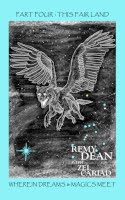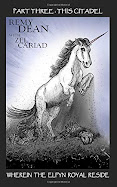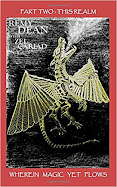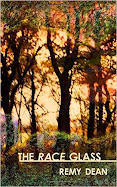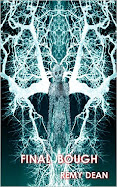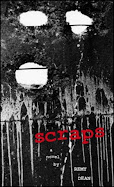Moonshadows slowly stretched across the valley, though they were shed by no ordinary full moon. It was a harvest ‘supermoon’, about to be painted blood-red by the combined refracted sunsets of our planet… What a great cosmic finale to Haus of Helfa 2015…
It had begun on the day of remembrance for Hiroshima - a glaringly bright and dark-stained chapter of Earth history - and ended in this humbling and beautiful global event. The stars shone brighter as the lunar light dimmed. I imagined standing on our (not-so-) distant sister satellite, watching the dark earth all but obscure Sol, save for its rosy halo setting our slight atmosphere aglow, uniting, encompassing us all in the endlessly black, star-stabbed sea of space…
Well, I thoroughly enjoyed this year’s Haus of Helfa, and judging from the reactions of the many visitors, so did a lot of other people. On behalf of the thirteen artists in ‘da haus’, a big “Thank you!” to all those who came to have a look and get involved. I particularly appreciated the many stimulating chats about some very deep creative concepts…
 |
| Doors opened to the public every weekend in September |
We love our audience…
There was a healthy creative atmosphere of competition, with no sense of rivalry, as each saw the others develop their varied outcomes, aware of what was in the next space. In this way, although each room contains a separate piece of work, the house itself does have a sense of, not quite collaboration, but a definite cohesion - perhaps owing much to the input of curators Sabine Cockrill and Marc Rees.
So, what were the motivations of all involved?
Although reasonable material costs were covered - and it was like being ‘given’ a studio, rent-free, for two months - this residency was not fee-paying. Sure, administrators were paid, but the artists were not! So the artists were doing this because they wanted to – that simple. This goes to show that, given half a chance, creatives will just get on with it. Driven by a need or a desire within, they will work very hard and consistently to produce something that can only enrich the local, and wider, communities. The success of Haus of Helfa has relied completely on this ‘generosity-of-the-self’ – it is a gift, from those artists involved, to us all.
Lucky for our contemporary culture, true art (whatever that may be in your opinion) is not money-motivated. So, what wonders would we witness, if more funding allowed artists the creative freedom that Haus of Helfa has offered… and what if…
What if more creatives were afforded the time and space to create?
This residency, sometimes referred to as the ‘flagship’ of the Helfa Gelf Art Trail, is now an essential part of Llandudno… and the diverse cultures of Wales… A little like Yuletide, it comes round but once a year, and as soon as it is over, we can only look forward to the next!
Until then, here is a brief recap and overview of what happened in ‘da haus’…
It is not over - until it is over
Through August, in the run-up to the residency, I started the writerly ball rolling by posting a song per day on twitter, themed around writing and writers. (Click here for these songs gathered as a YouTube playlist.)
Also via twitter, I broadcast a series of eight #WordsOnWednesday - these were linked with the objet on display in my ‘vitrine’ and with jottings lifted from my notepads and sketchbooks:
 |
| Words On Wednesday # 1, photograph and text by Remy Dean |
 |
| Words On Wednesday # 2, photograph and text by Remy Dean |
 |
| Words On Wednesday # 3, photograph and text by Remy Dean |
 |
| Words On Wednesday # 4, photograph and text by Remy Dean |
 |
| Words On Wednesday # 5, photograph and text by Remy Dean |
 |
| Words On Wednesday # 6, photograph and text by Remy Dean |
 |
| Words On Wednesday # 7, photograph and text by Remy Dean |
 |
| Words On Wednesday # 8, photograph and text by Remy Dean |
During the residency, I invited visitors to send themselves a postcard in response to a set of three stimuli. Thanks to those who did – click on the image below to see a mini-gallery of some of the results…
 |
| Notes to Selves: visitor-penned postcards on display in Haus of Helfa |
My exploration of attaching stories to artefacts took the form of 'Corky', the Cicorc Conwy. He was on show in my Haus of Helfa space and generated lots of interesting and delighted conversations from visitors of all ages. Grown-ups were charmed and children were highly engaged, even making up some cicorc stories of their own - unprompted - to tell me! In all, a surprisingly successful exercise in getting a piece of fiction across to a very varied audience. This experimental method of story-telling is something I will, definitely, be exploring further.
 |
| Corky (Left) was allowed out of his box to meet Sparky! |
I have already mentioned most of the art and a happenings that occurred, in previous posts here (part 1 + part 2 + part 3), though, since the last entry, the major event known as Llawn03 occurred.
Celebrating a colossal concoction of camp and creativity(!), the Llawn Festival is the biggest arts event in the North of Wales in general, and for Llandudno in particular. Over the weekend of 18 – 20 September, artists, performers, and guests from Wales, Europe and the World, descended on the historic seaside resort town to express and enjoy a multitude of… things: art, objects, events, open air cinema, poetry, comedy, stories, singing, dancing, bingo, abseiling, bathing, contraptions, knitting, automatons, food, drink, sunshine, sea and sand – not necessarily in that order. Something for anyone and plenty for everyone.
At the Haus of Helfa, things got well and truly underway at 8 o’clock, when guests from the official Llawn03 launch at Oriel Mostyn arrived to take full advantage of the free bar and chat with the resident artists and each other.
Full (Art) Haus!
Alan Whitfield hosted a session of Austerity Bingo. Sitting at the front of a gloriously camp bingo set, wearing a gloriously camp blue sequinned jacket, he took on the mantel of a northern bingo caller, veering from cheeky’n’cheery to grumpy’n’angsty. Whenever a ‘lucky-number-seven’ came up, he was compelled to recite a fragment of poetry, revealing thoughts and feelings otherwise hidden behind the repetitive act of calling out random numbers. (“89, your grandmother’s Welsh.”) Sat before him, at the rows of formica-topped, wood-effect tables, guests dabbed red dots, looking for patterns and meaning where there were none, and hoping for the luck-of-the-line or even a ‘Full House’ to win suitably austere prizes.
 |
| Alan Whitfield gets the bingo blues and channels the Tedder House binghosts |
Camping Out in Llandudno
Later that evening, Whitfield’s Bingo Hall provided the perfect setting for the light entertainment in the delightful form of Divina DeCampo (aka Owen Richard Farrow), a drag act with a difference: a fairly gentle and civilised sense of humour that did not play down to the bitchy stereotype, and a genuine voice talent! Whether drag acts are your cup of tea or not, this was ‘top entertainment’ in the fine tradition of seaside resorts. There was fun to be had at no-one’s expense. For me, Gilbert and Sullivan light opera is anathematic, but Divina kept just on the right side of send-up, whilst doing professional justice to the highs and lows. The more raucous Broadway hits were also pitched perfectly between parody and proper performance. I felt like I was back in Blackpool… The between-song banter with the audience was witty without vindictiveness. Although everything else was suitably false, the warmth and talent was not.
As the wine ran out, the Friday night launch drew to a close. The last thing I remember is photographer David McBride and a guest, Mark, having an ‘ambient-off’ using their smartphone playlists involving Byrne, Bowie and Eno… Then I had a short walk to the Llandudno Travelodge, which is so new it still smells like a table-tennis bat.
The remainder of the Llawn03 weekend was by far the busiest and, though I was mostly in the Haus of Helfa Bar, I did manage to sneak out to the Tabernacle Vestry to have a look at the installations there by two artists that had been Haus of Helfa residents last year…
The Artful Spirit
Angela Davies had set up a rotating, under-lit column of rods and lenses that acted as a vertical projector. One of the lenses was interchangeable and could be swapped for others that had been hand-crafted in blown glass. The images they projected onto the ceiling-mounted, circular screen were evocative of the macro- and micro- cosmic. Could this be a planetarium showing us distant planets and nebula? Are we seeing, “the transient creatures that swarm and multiply in a drop of water”? Or, given the setting, are these vitrified visions of spirits and angels? A beautiful and mysterious abstract that uses light itself and the process of seeing as its media.
 |
| Seeing the light - Angela Davies' installation in the Vestry |
These two pieces were not collaborative, though shown side-by-side in the vestry space, there was an undeniable dialogue between them. Slowly spinning and suggestive of great and small, using the properties and behaviour of light itself as an integral part of the works. This was a very good example of what Llawn03 is all about – using unusual spaces to showcase art. The old playing host to the new. What a beautiful discovery for the visitor following the festival guide - to wonder through a fairly unremarkable little door, down the side of an old church, and find such a poetic experience awaiting them!
Moving House
Around the back of the condemned Tudno Castle Hotel (where the furniture for the Haus of Helfa Writers’ Bar had been rescued from) another discovery awaited. Appearing at first to be a builder’s tarpaulin draped on scaffolding, we are drawn to what we soon discover is a huge and incongruous, rubbery crimson cast, of a house… a house that is conspicuous by its absence.
 |
| Getting under the skin - this is a Sobbing House, a house in which to sob... |
Another Man's Treasure
On the way back to the Haus of Helfa, we stopped by the Royal Cambrian Academy’s outreach expo, in a shop just along from the Mostyn Gallery. Here we saw some automatons on show: an antique pram that ceaselessly moved back and forth, a mannequin rotating on the spot and a motor that pulled a piece of iron girder up and down in an old cot. There was also a dolls' house painted a very similar crimson to the Sobbing House, perhaps as a homage. This imagery was lifted from the paintings of Shani Rhys James and explored themes of motherhood and the oppression of women and ‘home-makers’ - perhaps?
 |
| Dwsin - the treasured objects of (L-R) Marc Rees, Philip Hughes and Steffan Jones-Hughes |
This trilogy of assemblages was visually interesting and also contained unique biographical narratives. I appreciated the strong correlation with my own exploration of how words and associated objects accrue meaning additional to, and more complex than, their literal interpretations - such as BISCUIT, on show in the ‘vitrine’ back at the Haus of Helfa. It also reminded us that exhibitions and events such as Llawn, Helfa Gelf and Haus of Helfa, come about as the results of curatorial energies, selections and developments. Hats off!
All that is left...
The Llawn03 weekend blurred by and left one more final weekend to reflect and consolidate the whole gamut of experiences during the residency. I was glad that Sparky, the ‘traditional Prague upholstery dog’ (and my art-tours ‘mascot’, whom regular readers of this weblog may recognise) visited to meet ‘Corky’ the ‘traditional Conwy cork dog’, and had a good look round…
Coming soon: Sparky's Adventures in the Haus of Helfa... (watch this space)
MORE:


.jpg)



















